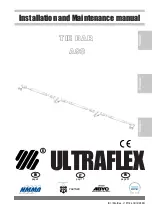
BLACOH Fluid Control
8
Adjustable Model
Read Before Installation
Step 1 – Air Line Connection
Using a 1/4” flexible air hose (I.D. of the hose must be 1/4” or 6.4 mm minimum) run an air line from a compressed gas
source to the one-way check valve on the dampener’s regulator.
DO NOT
remove one-way check valve. The check valve prevents fluid back flow through the air hose in case of bladder
failure. The air supply pressure to the dampener must be greater than the pump discharge and/or system pressure. If the
dampener is being used in conjunction with a pneumatically operated pump, a tee can be used to run the air line to the
dampener from the existing pump air supply line (see FIGURE 1). The tee should be placed
before
any in-line pump
instrumentation such as a filter, regulator, lubricator or other pump control valve.
Step 2 – Charging and Startup
Prior to starting the pump
, adjust the regulator on dampener to approximately
30%
of expected system pressure at the
pump’s
discharge
outlet. For example, if the liquid pressure at the pump discharge is 60 psi (4.1 bar), initial dampener
charge should be 20 psi (1.3 bar).
Note:
Dampener
must
be charged before the pump is started. If dampener pressure charge is set too high, then the bladder
will be squeezed and flow will be restricted. The most effective way to set the proper dampener charge is to install a glycerin-
filled pressure gauge downstream of the dampener and adjust the dampener to minimize needle movement on the gauge.
After the pump is started minor pressure adjustments to the dampener may be required to maximize dampener performance.
Since the dampener regulator is the self-relieving type, it is easy to raise or lower the dampener pressure to obtain best
dampening results.
Once system pressure is in contact with the bladder, the air charge will be compressed to the system pressure and
the dampener gauge will read approximately 1/3 to 1/2 of system pressure, not the initial charge pressure.
Once
working pressure is achieved, adjustment may be necessary. Gradually increase or decrease the air charge in the dampener
by bleeding or filling through the self-relieving pressure regulator. Allow the system to respond to each adjustment (this may
take a minute or two) before making further adjustments.
Maintenance and Repair
Read Before Installation
The only maintenance required is the periodic checking of the gas pressure charge on the Chargeable model.
Normally, if dampener is properly installed, pre-charge pressure should be checked every two to three months or
when dampener effectiveness is reduced, which indicates a loss of charge. Refer to charging instructions above.
Bladder Replacement
IMPORTANT! Bladder must be installed in one direction only or bladder damage will occur. The side of the
bladder has an arrow molded in it indicating the direction of fluid flow inside the dampener. The arrow on the
bladder must point in the same direction as the arrow on the dampener body. Dampener must be installed in
the system with the arrow on the dampener body pointing away from the pump in the direction of fluid flow.
1. Before replacing the bladder, dampener must be removed from the pipe system.
2. To remove the bladder, fold the bladder lip seal down into the center of the bladder while pulling the bladder
out from the opposite end of dampener body.
3. To install a new bladder, insert the bladder into one end of dampener body as far as it will go. Reach into the
opposite end, fold the lip seal edges toward the bladder center and pull the bladder end out of the body.
Pushing the bladder from the opposite end while pulling will assist in bladder installation. A sanitary/food grade
oil can be applied to the lip seal to help with installation.
4. If dampener is used in a sanitary application, dampener body must be cleaned and sanitized internally before
reuse after repair.
Summary of Contents for SENTRY CIP
Page 10: ...9 BLACOH Fluid Control NOTES ...






























